New Crosslinkers for Polyurethane Powder Coating

This article focuses on Bayer's newest polyisocyanate based powder crosslinker developments in an attempt to address these issues. Two of these crosslinkers are fully commercialized and the other three are in the process of being commercialized.

Chemistry of Powder Crosslinkers
Crelan VP LS 2347 powder crosslinker was designed to achieve the highest NCO content of any non-emissive crosslinker on the market today. With an NCO% of 19.5 (216 g/eq), a functionality of 2, and a glass-transition temperature (Tg) of 70 deg C, it is an isophorone diisocyanate (IPDI) based self-blocked uretdione type crosslinker. An idealized structure is shown in Figure 1. Uncatalyzed curing with conventional hydroxyl polyesters is achieved in 15 minutes at 180 deg C.Crelan VP LS 2386 powder crosslinker was designed to provide the maximal level of isocyanate content for crosslinking while minimizing the level of blocking agent. Structurally, it is based on the combination of uretdione adduct of IPDI and partially e-caprolactam blocked IPDI. This crosslinker provides 25.5% NCO, 165 g/eq, an average functionality of 2.0 and a Tg of 52-58 deg C. The idealized structure is shown in Figure 2.

Crelan VP LS 2181/1 powder crosslinker was designed to provide controlled gloss reduction through the incorporation of both blocked isocyanate and carboxylic acid functional groups on the same molecule. The structural basis for the crosslinker is the combination of isocyanate adducts blocked by e-caprolactam and a carboxylic acid functional group (see Figure 3). The acid value is 70 mg KOH (801 g/eg), and the % NCO is 10.5 (400 g/eq). The overall functionality is 3, where the molecular average functionality is 2 blocked isocyanates and a single acid functional group per molecule. The Tg is approximately 70 deg C and the appropriate curing schedule is 200 deg C for 15 minutes.
Crelan NW 5 powder crosslinker is based on the adducts of Desmodur W diisocyanate blocked by caprolactam. This crosslinker was designed to capitalize upon the positive attributes of Desmodur W. These include higher reactivity in comparison with other caprolactam-blocked isocyanate crosslinkers, excellent weatherability, high flexibility and impact resistance in the final formulations while maintaining high hardness and solvent resistance. Caprolactam blocked Desmodur W diisocyanate, has been shown in uncatalyzed formulations to reduce the necessary curing temperatures by up to 20 deg C in comparison with IPDI or HDI based crosslinkers. NW 5 has a Tg of 54-58 deg C, a melt viscosity of 4500-7500 cPs and develops excellent properties when cured at 160 deg C for 20 minutes (see Figure 4).

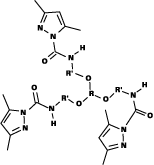
Coatings Formulations, Processing and Performance
VP LS 2347
The formulation shown in Table 1 shows typical loading levels with this high NCO crosslinker. The 90/10 ratio of binder to crosslinker ratio capitalizes on the higher NCO content and provides excellent performance. This formulation was premixed using a Prism Pilot III Premixer that was maintained at 2500 rpm for 2 minutes. The premix was melt processed through a Buss PLK 46 twin screw extruder set at 100 rpm and 100 deg C and 120 deg C for zones 1 and 2, respectively. The extrudate was pulverized by way of a Hosokawa Micropul ACM II providing a 35-micron average particle size. 
The performance of the crosslinker is also compared to a conventional uretdione-based powder crosslinker in Table 2. Each of these formulations provides similar mechanical performance and solvent resistance at the appropriate loading levels.

VP LS 2386
Two example formulations containing VP LS 2386 are shown in Table 3, one with a 30-hydroxyl polyester and the other with a 50-hydroxyl polyester. These formulations were processed using a Prism Pilot III premixer set at 2500 rpm for 3 minutes. The premix was melt processed by a Buss PLK 46 twin screw extruder at 100 rpm with zones 1 and 2 set to 100 deg C and 120 deg C, respectively. The extrudate was pulverized using a Hosokawa Micropul ACM and resulted in an average particle size of 35 microns. The final powder coatings were applied to aluminum panels and cured at 180 deg C for 15 minutes and gradient oven panels were cured for 15 minutes ranging from 160-190 deg C. These white high gloss powder coatings provided 60 deg gloss values of greater than 90 while developing excellent mechanical properties. The higher hydroxyl value polyester supplied higher solvent resistance as expected.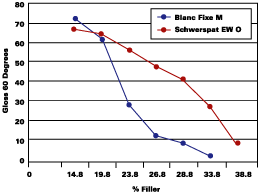
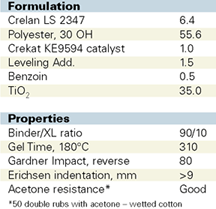
VP LS 2181/1
The bi-functionality of VP LS 2181/1 provides the formulator the ability to adjust gloss to any desired level by using a blend of conventional powder crosslinkers. The formulations shown in Table 5 are examples of the crosslinker used alone. The formulations were processed using a Prism Pilot III premixer at 2500 rpm for 2 minutes. This premix was then melt processed using a Buss PLK 46 twin screw extruder set at 100 rpm and zones 1 and 2 were set to 100 and 120 deg C, respectively.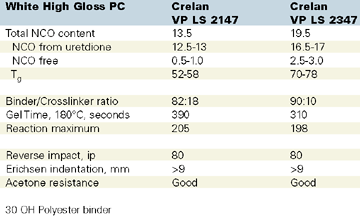
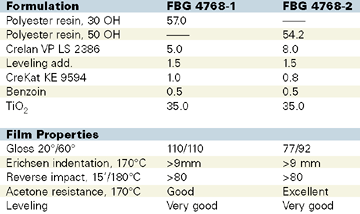
Consistent with the majority of powder coatings, powder coatings based on VP LS 2181/1 also exhibit a reduction in gloss with an increase in pigment, extender or filler concentration. Figure 8 displays how rapidly gloss levels drop with higher filler contents.

NW 5
A high-gloss white powder coating formulation based on Crelan NW 5 is shown in Table 6. This powder coating was premixed using a Prism Pilot III premixer set to 2500 rpm for 2 minutes. The premix was melt blended using a Buss PLK 46 twin screw extruder set at 200 rpm and zone 1 and 2 temperatures of 90 and 100 deg C, respectively. The extrudate was pulverized to an average particle size of 51 microns. The final powder coating was applied to Bonderite 1000 panels and cured for 20 minutes at 180 deg C. The powder coating exhibits excellent film appearance, mechanical properties, solvent resistance, and overbake stability.
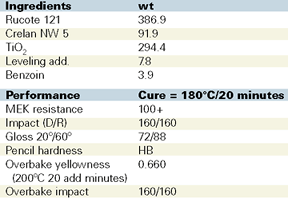
XP 7180
The XP 7180 based formulation shown in Table 9 was premixed for 3 minutes at 2500 rpm. The premix was then processed by way of a Buss 26 mm twin screw extruder with Zone 1 set to 45 C, Zone 2 set to 65 at 250 rpm and maintained at 80% torque. These conditions produced a final extrudate melt temperature of 105 deg C. The extrudate was pulverized to an average particle size of 50 microns. The final powder coating formulation gelled in 162 seconds at 190 deg C and flowed 1000 mm by PCI test method for Inclined Plate flow. The results shown in Table 10 are derived from gradient oven panels. The performance data in Table 10 provides a look at the low temperature curability of XP 7180. This uncatalyzed formulation provides excellent impact resistance when cured as low at 150 deg C for 20 minutes. The low solvent resistance indicates that the formulation has not developed its ultimate properties with this curing profile, however at 165 deg C 20 minutes the powder coating is fully cured and maintains excellent mechanical properties.
Summary
Advances in polyurethane powder coatings crosslinker were presented in a context of meeting the powder industries needs. Higher NCO content crosslinkers, such as VP LS 2347 and 2386, translate to lower equivalent weights and reduced crosslinker demands; yet the performance is maintained when these crosslinkers are used as demonstrated by the example formulations. Additionally, VP LS 2181/1 clearly provides controlled gloss reduction for polyurethane powder coatings by blending with conventional crosslinkers and combining an acid co-reactant such as hydroxy alkyl amide, TGIC or GMA acrylics. Reduced curing temperatures are possible by incorporating NW 5 as a replacement for conventional IPDI-based caprolactam blocked crosslinkers. Desmodur W-based crosslinkers have proven to provide lower curing temperatures, higher impact resistance, excellent weatherability, solvent resistance while simultaneously maintain high hardness levels. XP 7180 offers even more drastic curing temperature reduction by utilizing 3,5-dimethyl pyrazole as the blocking agent.Acknowledgements
The authors would like to express thanks to the following people for their input to the body of research and development discussed above: Michael Grahl, Frake Chmielewski, Tom Stadermann, Larry Smedley, Eric Vidra, Katherine Ratliff, Mike Jeffries, Lanny Venham, Reinhard Halpaap, and Hans Laas.This article was presented at the International Waterborne, High-Solids, and Powder Coatings Symposium February 6-8 in New Orleans. The symposium is sponsored by The University of Southern Mississippi Department of Polymer Science.
For more information contact Bayer Corp., 100 Bayer Road, Pittsburgh, PA 15108; phone 800/662.2927; fax 412/778.4451; visit bayerpowder.com; e-mail carl.sullivan.b.@bayer.com; or Circle Number 123.
References
1 P. Thometzek, H Basten, K. Kohler, H.-U. Meier-Westhues, Fabe & Lack 104, 22 (1998).2 H.-U. Meier-Westhues, P. Thometzek, H.-J. Laas, Farbe & Lack 103, 140 (1997).
3 U. Freudenberg, U. Meier-Westhues, H.-J. Laas, European Coatings Journal 9, 804 (1997).
4 Freudenberg, Ulrich and Thometzek, Peter, Weather Stable, Low-Gloss Powder Coatings, Proc. Int. Waterborne, High-Solids, Powder Coatings Symp., (1999), 26th 216-231.
5 Thometzek, Peter, Many promising powder coating perspectives, Coating (2001), 34(7) 243-246.
Links
Looking for a reprint of this article?
From high-res PDFs to custom plaques, order your copy today!






